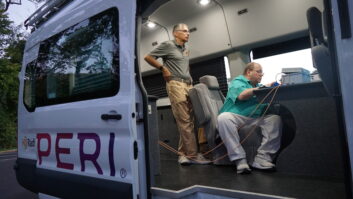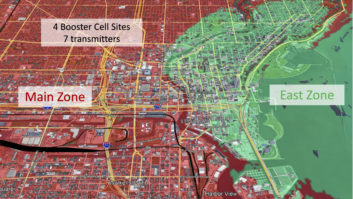Field Report: FM Services TLM-1
Apr 1, 2011 1:00 AM, By Michael Bradford, CPBE
I can’t tell you how many stations I have noted in past years with incandescent tower lighting systems which have no method to fulfill all monitoring requirements of the FAA and FCC. Too many times to remember, I found photo controls that failed with no alarm, flasher modules that failed in the “constant on” mode with no alarm, or flashers that went squirrelly and were flashing 55 times a minute or only four times a minute … all with no alarm from the simple current transformer “monitor” that was installed.

Given that the FCC has issued fines in excess of $7,000 for “wanton and continued” failures in tower lighting, it only makes good sense to have a lighting monitor that will fulfill all pertinent requirements.
After completing a due diligence inspection for Holy Family Radio at a three-tower directional array east of Grand Rapids, MI, I discovered the simple current transformer-based “monitors” simply did not meet all the requirements of the FAA/FCC as detailed in the Rules. I spent a lot of time pouring over various catalogs trying to locate a single system or a module to comply with all the Rules when I remembered a Field Report in Radio magazine from 2009. I dug into my back-issues and found the information I needed on the TLM-1 system module. According to the description, the TLM-1 seemed to respond to all failures that required a call to the FAA and issuance of a NOTAM.
Performance at a glanceIndividual alarm outputs
Status outputs for lights on/off and beacon on/off
LED indicators for each alarm and status output
Opto-isolated outputs
Insures FAA lighting compliance
I contacted the manufacturer, Stoney Owen, at FM Services in Wilkesboro, NC, to discuss the TLM-1 in detail. Two days later, I had a TLM-1 module in my hand.
Here’s a microprocessor-based system designed to monitor a tower’s beacons, obstruction lamps, flash rate, photo control operation — even the presence of an ATU heater bulb for winter months. This neat little device shows superb design qualities and thoughtfulness; it comes in a clear plastic case for easy mounting and access to the calibrate and reset buttons. All connections are via euro-style barrier strips. DIP switches allow you to customize the system for specific remote control interfacing. The current transformer with the TLM-1 is a separate device and can be easily mounted inside the service panel with the tower lighting breaker. This allows the monitor module to be mounted separately from the service panel location for easy viewing of the status and alarm LEDs and connection to a remote control system.
When all the lights are on and operating as normal, pushing the calibrate button causes the TLM-1 to store this data and compare future operation with these normal values. Individual beacons, obstruction lamps, flasher operation or photo control operation can be monitored with an individual opto-isolated status output. There is also a common alarm status output on each module that alerts any failure.
The TLM-1 comes with its own wall-wart power supply, but it can be powered with 9-12Vdc/ac at 100mA locally if desired.
My installation
My specific need was for a two-tower monitoring system for the three-tower array. As only two of the three towers are required to be illuminated, I needed two of the TLM-1 modules. I designed the basic layout to fit a Stahlin JW1210HPL enclosure with a solid aluminum type BP1210AL back-panel. This model comes with a weather-tight clear cover so the TLM-1 status and alarm LEDs can easily be viewed with the door closed. I also chose to use a universal input power supply module to power the two TLM-1 boards that I obtained from Digi-Key (part number 285-1747-ND). I installed a 1/4 x 20 brass bolt for a solid ground connection on the Stahlin solid aluminum back-panel, and a jumper to eachTLM-1 circuit board’s ground lug for protection.

I connected the two TLM-1 commons together and use the individual alarm outputs to monitor each tower separately with the station’s Sine Systems RFC-1B.
I chose to program the alarm outputs for normally on so the remote control channel assigned to each tower will reply with status on for a normal, no alarm situation. Should there be a failure in a beacon, flasher or photo-control, the remote will send a message to the Holy Family Radio control center so that the required call to the FAA reporting center can be made and the NOTAM number logged. Once the repairs are made, the TLM-1 can be re-calibrated and returned to normal operation.
The TLM-1 comes in a plastic enclosure when delivered, but the circuit boards have drilled and plated holes in the corners for custom installation. The TLM-1 will monitor up to eight 620W or six 700W beacon bulbs and eight 116W obstruction bulbs in a 120Vac lighting system.
FM ServicesP
W
E 336-667-7091
www.towermonitor.com
[email protected]
I am writing a letter to the Commission and the FAA to request relief from the requirement of a visual quarterly tower light inspection as required in the Rules given the extent of the status monitoring provided by the TLM-1 system.
Bradford is the owner of Broadcast/Audio Services, Jackson, MI.
Editor’s note: Field Reports are an exclusive Radio magazine feature for radio broadcasters. Each report is prepared by well-qualified staff at a radio station, production facility or consulting company.
These reports are performed by the industry, for the industry. Manufacturer support is limited to providing loan equipment and to aiding the author if requested.
It is the responsibility of Radio magazine to publish the results of any device tested, positive or negative. No report should be considered an endorsement or disapproval by Radio magazine.
April 2011
HD Radio monitors ,choosing an audio over IP network switch, a look at the Clear Channel Chicago rebuild, transmission line pressure monitoring, and Field Reports on the FM Services TLM-1 and Audio-Technica AT4040….












